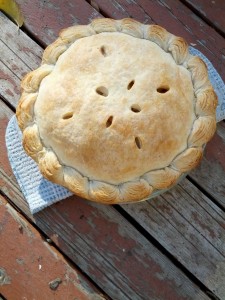 Some detailed notes on a North American staple.
Some detailed notes on a North American staple.
The Dough. I take for granted that you already know how to make a superlative, flaky pie dough. If you don’t, this pie dough is a good start, but you should probably add a handful of sugar to the mix.
The Filling. The first important consideration for the filling is the variety of apple to be used. High acidity and firm, crisp texture are key. Of the common commercial varieties, Granny Smith is probably the best, but there are lots of varieties growing within the Edmonton city limits that make good pie. Sweetness, of course, is also desirable, but we can balance the tartness of the apples with sugar. Look for acidity above all else.
It goes without saying that the apples will be cored and peeled, as apple seeds and cores are inedible, and apple skins are practically inedible once they have been cooked. Once the apples are processed in this manner, we must take pause to contemplate one of the tricky bits of apple pie. Apples don’t form a semi-fluid, cohesive filling like, say, sour cherries, or rhubarb, or puréed pumpkin. They remain distinct chunks of fruit, and yet manage to hold together as you serve the slices. This is the charm of apple pie.
Since we have already selected a firm, crisp apple, the size that we cut the fruit is what will determine the final texture of the filling. If we cut the apples very fine, the filling will be cohesive, but we risk over-cooking the fruit and making apple sauce. Leaving the apples in large pieces will ensure that they keep their texture, but will probably result in the filling falling out of the shell when we try to serve individual slices. Bad grocery-store apple pies tend to leave the apples very large, but then bind them with a syrup thickened with cornstarch.
So we must find a balance. For my money, it is best to quarter the apples, then slice the quarters across their long axis into pieces no more than 1/4″ wide.
As for the flavouring agents of our filling, it is impossible to talk about apple pie without mentioning cinnamon. The flavour of cinnamon is so connected with that of apples in most people’s minds that you could, for instance, make a pie filling out of Ritz crackers, lemon juice, and cinnamon, and most people would swear that there are apples in it. Cinnamon is tried, tested, and tasty.
Nutmeg is also good.
We must also sweeten our apple filling. I like to use dark brown sugar. Also: a bit of rum. This is a common flavouring in apple strudel, and I’ve grown very fond of it.
A bit of salt, too.
Building an Apple Pie. Build it tall, so that the apples at the centre of the pie are piled above the level of the pie dish and the circumferential crust.
How to Eat Apple Pie. Almost any classic, sweet pie is fine when accompanied by whipped cream or ice cream. However, I think that acidic pies like sour cherry and rhubarb go best with ice cream, which tempers the acidity of the filling. Apple pie is lower in acid, and much more naturally balanced. Serving apple pie with ice cream only kills the flavour of the filling. So whipped cream is preferred, and this is perhaps how apple pie was enjoyed for centuries, before a great, great man decided to eat his apple pie with cheddar cheese. The resulting balance of flavour is similar to salted caramel. I suggest Balderson two year old cheddar. Do this. It’s part of your heritage.
Apple Pie
Ingredients
- 1 kg apples, peeled, cored, quartered, and cut across the long axis into slices not exceeding 1/4″ in width
- 150 g dark brown sugar
- 10 g rum
- 20 g oatmeal flour (Just grind up rolled oats in a blender.)
- pinch of kosher salt
- 1 kg flaky pie dough (This is more dough than you’ll need, but I hate having to stretch dough to make a pie. Better safe than sorry.)
Procedure
- Toss the sliced apples, brown sugar, rum, oatmeal flour, and salt in a large bowl.
- Divide the dough in half. Roll out one half to roughly 1/8″ and line the pie dish.
- Pile the apple filling into the dish.
- Roll out the other half of the dough and cover the apple filling. Seal the edges as desired. Make some small incisions in the top of the dough to vent the filling.
- Bake the pie on the bottom third of a 425°F oven for fifteen minutes, then lower the heat to 350°F, move the pie to the top third of the oven, and continue baking until the dough is well browned and the interior is bubbling, roughly another forty minutes.
- Let the pie cool to just above room temperature, then consume with cheddar cheese.
